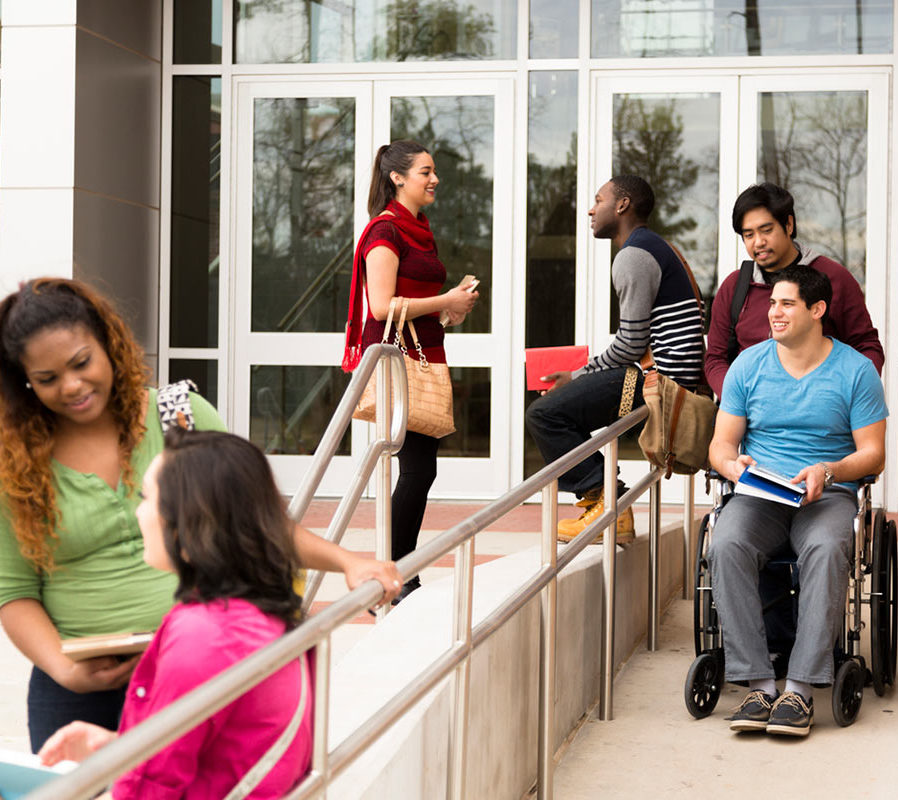Introduction
Creating accessible teaching and learning institutions for disabled students, staff, and faculty means removing barriers in the practices, norms, and beliefs found within an institutional culture. Everyone should have access to a barrier-free environment and true accessibility means proactively taking action to create access across our institutions.
Below, we review what accessibility and access means in educational contexts.
Accessibility and Access
Accessibility, simply put, means being able to access something without barriers. For Titchkosky (2011), “access is a way people have of relating to the ways they are embodied as beings in the particular places where they find themselves.” Accessibility requires proactivity and planning. It is not individual accommodations or retrofits that occur after the fact. Instead, we need to think about access and accessibility beyond just individuals but within systems and norms as well.
True accessibility and access means disabled people can exist as themselves in relation to their surrounding environments. As Emily Ladau (2021) puts it, “accessibility is about making things more equitable so that disabled people have the same opportunities and support to thrive as do nondisabled people.” Accessibility is not about convenience — that is, if something is inaccessible it is not simply an inconvenience for the individual. Instead, if something is inaccessible, it is exclusionary.
Accessibility, Disability and EDI
In postsecondary discourses, EDI (Equity, Diversity, and Inclusion) has become a catch-all phrase to address and label systemic inequities within higher education. Accessibility and disability, however, are often absent from EDI discussions in postsecondary education. A 2021 review of EDI focused academic literature found little to no engagement with disabled students and staff (Wolbring & Lillywhite, 2021). The authors point to a necessary need to “critically analyze EDI efforts in relation to disabled students, non-academic staff, and academic staff, the intersectionality of disabled people with other EDI groups and the impact of the EDI efforts on the social situation of disabled people beyond educational settings” (Wolbring & Lillywhite, 2021). The lack of engagement and centering of accessibility and disability within EDI discourses needs to be addressed and changed if we are to truly embrace the possibility of an accessible postsecondary sector.
Accessibility and Education
A 2017 report by the Canadian Human Rights Commission found that barriers in education cause close to 10 percent of individuals with disabilities to quit pursuing their educational goals before achieving them (CHRC, 2017). The OHRC outlines the main barriers to education for students with disabilities (including postsecondary students) as inadequate funding, physical accessibility, the accommodation process, lack of individualization, ineffective dispute resolution mechanisms, and negative attitudes and stereotypes.
These barriers and more are prevalent for students in the postsecondary sector. Prioritizing efforts to achieve barrier-free access for disabled students beyond just individualized academic accommodations is critical. First, accommodations do not equal true access for disabled students. Accommodations are retrofits to an inaccessible environment that do not empower us to make changes. As Dolmage (2017) notes, “The nature of the retrofitted accommodation requires that we make no lasting changes to our pedagogy or to the culture.”
Second, academic accommodations do not equitably serve disabled students within teaching and learning institutions. Many students that need academic accommodations either do not receive them or do not seek them. Some have estimated that at least 100,000 postsecondary students in Canada (if not close to 200,000 students) need accommodations but never seek them (Dolmage, 2017). Olson (2015) cites a variety of reasons that prevent students from accessing the required medical documentation to access academic accommodations including lack of access to medical care, lack of financial means, barriers to adequate healthcare and documentation, and more.
Moving past a compliance framework to approach accessibility is one way to ensure equity for disabled students. As Harry Paul has pointedly asked, “if you recruit disabled students, are they going to feel like their disability is a burden that the school is complying with as it’s the law…or are they going to feel like they are valued for their perspective?” (as cited in Burke, 2020).
Summary/Key Takeaways
Focusing on accessibility and the removal of barriers is imperative for our teaching and learning institutions if we are committed to equity and student learning. Further, accessibility is not just for students. Disabled staff, faculty, and community members who are present within our institutions deserve full access and the removal of barriers as well.



